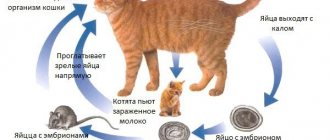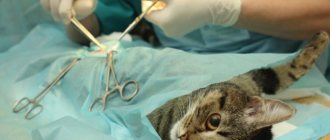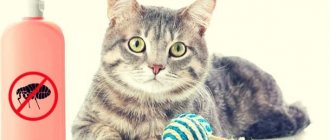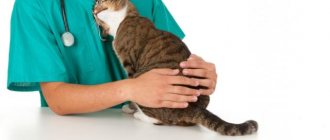Worms in cats: types
Types of worms in cats are classified according to the type of worm:
- Roundworms are nematodes.
- Tapeworms are cestodes.
- Flatworms – flukes, trematodes.
The sizes of helminths vary greatly - from a few millimeters to 1.5 meters. The location of the parasites also differs.
The most common places of parasitism:
- digestive tract;
- liver and bile ducts;
- heart;
- lungs;
- bladder;
- eyes;
- kidneys
The intestines and stomach are most often infected - they are inhabited by toxocara and roundworms. As well as the liver, which is affected by the invasion of the liver fluke.
Diagnostics
At home, parasites are identified by particles of worms, eggs in the feces and vomit of the pet.
In the clinic, helminthiasis is diagnosed using laboratory tests, x-rays, and ultrasound:
- Stool analysis reveals worm eggs. At an early stage, immature individuals live in the body, so they are not detected, and the study is repeated later.
- Sputum analysis and chest x-ray detect pulmonary parasites.
- Ultrasound diagnoses helminths in internal organs: heart, liver.
- A blood test determines the number of leukocytes; infection is accompanied by an increase in the number of eosinophils.
The symptoms of parasites resemble those of gastrointestinal diseases, poisoning, and colds, so worms can only be detected with 100% accuracy using laboratory methods.
Nematodes
Roundworms most often parasitize the small intestine, esophagus, and infect the liver. Nematodes are able to penetrate the kitten’s body even when it is in the womb. Therefore, roundworms are most often found in kittens up to 2 months old, while they are feeding on their mother’s milk.
Nematodes are the causative agents of helminth infections such as hookworm disease and toxascariasis.
Hookworm
Hookworm is a round white parasite with a slightly reddish tint, up to 2 cm long, which inhabits the small intestine. The worm bites through the mucous membrane to feed on blood. As a result of its activity, many bleeding wounds appear, which leads to blood loss in the cat. Helminths live in the host’s body, and their larvae exist for a long time in water and soil and move long distances during rain. One female lays up to 16 thousand eggs daily.
Infection occurs in 2 ways:
- Through the mouth, when the cat licks itself, it eats food contaminated with larvae. An outdoor cat becomes infected through the rodents it hunts. Mice are carriers of this type of parasite. In the body of a rodent, hookworms can exist for up to 10 months and remain viable. Entering the cat’s intestines through the mouth, the larva after 2-3 weeks turns into an adult capable of reproduction.
- The larvae burrow through the skin and then migrate through the blood vessels. Hookworms enter the trachea, which causes the pet to cough. When coughing, the larvae enter the mouth, then the animal swallows them, and they end up in the stomach and intestines. After about 3 weeks, a sexually mature worm is formed from the larva.
Routes of infection and general signs of pathology
Most often, parasitic worms enter a cat's body orally, that is, through the mouth. An animal can eat a sick bird or mouse, plants, spoiled food, or drink from dirty water bodies.
You can also become infected with worms from a cat that is already sick. Another method of transmission of parasites is transdermal and intrauterine infection.
The clinical picture of almost all types of worms is the same. First of all, these worms have a negative effect on the organs of the digestive system. The pet refuses to eat, begins to lose weight, and becomes weak. He doesn't want to move, his fur is getting dull.
© shutterstock
Vomiting, nausea, problems with stool, itching in the anal area, gas formation, and blood in the feces are often observed. You can also find the parasites themselves near the anus . When the doctor checks your pet, he will notice that the cat's liver is slightly enlarged.
Flukes, trematodes
Flatworms are much less common in cats. They cause diseases such as paragonimiasis and opisthorchiasis.
Paragonimiasis
The pulmonary fluke or pulmonary fluke is the name of the parasite that causes paragonimiasis. This is an oval-shaped trematode up to 1.5 cm long and up to 1 cm wide. Intermediate hosts are mollusks and crayfish. A cat becomes infected by eating crayfish. From the intestines, the parasite enters the lungs, where it causes bleeding and inflammation.
Symptoms of lung parasites:
- Coughing up blood.
- Wheezing in the lungs.
- Tremor.
- Possible increase in temperature.
- Vomiting foam.
- Diarrhea.
- Lack of appetite.
The pulmonary fluke causes symptoms often similar to those of tuberculosis, bronchitis, and lung cancer. When neglected, it is fatal.
Opisthorchiasis
The liver and gallbladder are parasitized by a species of trematode that causes opisthorchiasis. Opisthorchis worms or cat fluke enter the cat's body through intermediate hosts - fish of the carp family. Flukes damage the walls of the ducts and often cause them to become blocked. Very often, infection creates favorable conditions for the addition of a bacterial infection.
Symptoms of opisthorchiasis:
- Big belly, it hurts.
- Jaundice.
- Upon palpation, the doctor notes thickening of the liver and the presence of tubercles on it.
- Loss of appetite is accompanied by gluttony.
- The fur is tousled.
- Diarrhea alternates with constipation.
- Vomiting with a yellow substance.
TOXASCARIDOSIS
Toxascaris leonine is a toxascarid, a round helmin of the class Nematoda, family Ascaridae (roundworms). Males are 4-8 cm in length, females are 6-10 cm. The body is light yellow in color, the oral end has three lips and lateral wings. The eggs are oval or round in shape, thick-walled, with a smooth surface.
Routes of infection
Helmin is ubiquitous. The infection rate in cats is approximately 20%.
- An animal on a street walk can become infected by licking city/village dust from its fur or paws (oral-fecal route of infection).
- Mousecatching cats are at risk because Toxocara uses rodents as possible intermediate hosts.
- When eating raw meat in a diet contaminated with helminth eggs.
- A person can bring eggs into an apartment on shoes, clothes, or bags.
- The larva passes through the placental barrier, and the kittens are born already infected
. Transmission through breast milk is also possible.
Life cycle
An infected animal releases toxascarid eggs into the external environment with feces, which are carried by a host of carriers (flies, cockroaches, lice, fleas, rodents, etc.). Once ingested, the egg hatches into a larva that burrows into the submucosal layer of the intestine. In this place she molts twice. This period can last up to one month. After this, the larva returns back to the intestinal lumen and develops into an adult sexually mature individual. The lifespan of toxascarids is 7-8 months. The fundamental difference from toxacorosis is the absence of a larva migrating through the bloodstream.
The definitive host for Toxascaris leonine is cats, dogs, and fur-bearing animals.
The paratenic host is rodents (the larva is encapsulated).
There are no reported cases of human toxascariasis infection in the literature.
Symptoms
The main symptoms are associated with the introduction of the larva into the submucosal layer of the intestine, which causes inflammation and the development of gastroenteritis. The animal's eating behavior changes, appetite decreases, digestive disorders (vomiting, diarrhea) are possible, and the animal loses weight. With massive invasion, intestinal obstruction may form. Phenomena of protein and mineral deficiency in the animal are also observed.
Features of the treatment of helminthiasis
Against worms, complex preparations are mainly used in the form of tablets, suspensions, drops on the withers, which act against nematodes and trematodes. Despite this, if you suspect worms, you should contact a veterinary clinic to determine the specific type of parasite.
Most anthelmintic drugs are intended for one-time use. However, in case of severe helminthic infestation, re-application will be required 2 weeks after the first treatment.
They begin treatment for worms only after making sure that the cat has no other diseases.
When treating helminthiasis, it is recommended to additionally use Gamavit. This is an immunomodulator.
During pregnancy and lactation, cats are dewormed only when absolutely necessary and under the supervision of a veterinarian.
If kittens are infected in the womb, treatment is allowed only 21 days after birth.
The use of human anthelmintics in cats is strictly prohibited.
General symptoms
Their severity depends on several factors:
- type of helminth;
- degree of damage;
- individual characteristics of the animal's body.
At the early stage of worm infestation, you may not notice the changes characteristic of this process. Over time, a whole range of symptoms of infection develops, characteristic of all types of worms:
- Changes in the color and consistency of feces. Since many worms adhere to the intestinal walls, damaging it, minor bleeding occurs. This leads to a change in the color of the stool to black or the appearance of streaks of blood. Diarrhea or prolonged constipation is also an alarming sign indicating the presence of a parasite.
- The appearance of the animal’s fur changes, it loses its shine, becomes dull, as if “lifeless.” This occurs due to dehydration and lack of nutrients, because the worm feeds at the expense of its host.
- Pallor of the mucous membrane of the gums and oral cavity, which is a sign of anemia caused by the presence of parasites.
- Loss of appetite – the animal begins to eat less and, as a result, loses weight.
- An increase in the size of the abdomen occurs during massive infection, when there are a lot of helminths. But this symptom also occurs in other diseases.
- Itching of the anus - the cat often licks and scratches it.
- Yellowing of the sclera of the eyes.
- Frequent coughing.
- Change in behavior - the pet becomes lethargic, sleeps a lot and plays little.
- The appearance of vomiting. This is a nonspecific sign that occurs in many other gastrointestinal pathologies, but it is undoubtedly alarming and may indicate the presence of worms in the cat’s body.
All symptoms are nonspecific and may be signs of other conditions and pathologies. If you notice one or more signs of illness in your pet, you should consult your veterinarian as soon as possible.
Danger to humans
There are helminthiases that can be transmitted from pets to humans:
- alveococcosis;
- diphyllobothriasis;
- dipylidosis;
- dirofilariasis;
- toxascariasis.
The main route by which helminths are transmitted to humans is through food and through contaminated hands. The above diseases lead to severe illness and even death. Therefore, deworming of domestic animals is also a primary measure to prevent human infection.
Prevention of infestation
To prevent helminthiasis, veterinarians recommend following the following rules:
- deworm your pet at least once every three months, especially before vaccination or mating;
- Regularly treat your cat for external parasites;
- feed the animal with proven food, special food;
- observe hygiene rules and promptly clean the trays after the animal.
If you follow these simple rules, you will make life much easier for your pet and yourself. Remember that almost all helminths live in the human body, and not all of them can be diagnosed and treated 100%. Take care of yourself and your pet!
Contraindications for deworming
You should stop taking antihelminthics in the following cases:
- if the product is not intended for use at this age, for example, in kittens;
- prohibited for use in sick and/or elderly pets;
- Contraindicated during pregnancy and nursing kittens.
For preventive purposes, it is recommended to carry out deworming once every 3 months.
Flea remedies
Before deworming, you need to get rid of fleas, which are an intermediate host for worms. Currently, veterinary pharmacies provide a wide range of products to help cope with this problem.
Most used:
- Drops on the withers. Distributed throughout the fur. For example, Advantage.
- Sprays. For example, Frontline.
- Shampoos are most often used to get rid of fleas in small kittens. For example, Rolf Club.
- Collars are more suitable for prevention. Hartz et al.
- Powders are approved for use in pregnant cats.
The most effective way to get rid of fleas is a combination of several types of products. For example, wash the animal with shampoo and treat the fur with spray.











